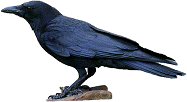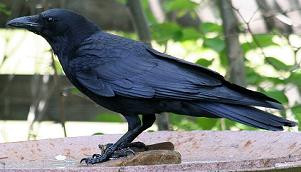American Crow 
Identification and Pictures
(Corvus brachyrhynchos)
The American crow or Common crow is a large,
chunky, all black bird, about 17 to 21 inches. The
feathers have a glossy shine to them, and in strong sunlight
they can have a purplish hue. They have a large, thick,
black bill, and strong, black legs, and feet. The wings
are broad, and rounded, and they have a short rounded
tail. Their flight is a slow deliberate wing beat.
Both sexes look similar. Young birds look like the adults, but
have blue eyes. Crows are fairly intelligent,
and sometimes mischievous birds, which are very good at
problem solving. They are able to recognize, and
remember individual people, and pick them out of a crowd.

Photo by Keith
Lee. The camera I use is the Canon
EOS 40D.
Visit All-birds store
Sound
They have a number of calls they use for
communication. Their most notable call is a loud caw
caw, given as they thrust their heads up and down.
Sometimes family members will do coordinated duets. They
are also able to mimic the sounds of other animals. Listen
to crow
Preferred Habitat
They range across Canada in summer, and most of
the U.S. all year long. They can be found in woodlands,
river groves, farms, fields, and shores. They do well
around people, and are often found in towns, around parks, cemeteries,
lawns, garbage dumps, and parking lots. They are often
seen in tree tops, on telephone poles, and along
roadsides. Crows are very social birds, and are often
found in large groups, sometimes numbering into the
thousands. In winter communal roosting groups may be in
the millions of birds. Some roosting groups have been
forming in the same areas for hundreds of years. Crows
may establish year round territories for their family, but
will also leave this territory to join with the large groups
for foraging, and roosting. Foraging flocks may post
sentries to watch for and warn the others of
predators.
Breeding and Nesting
Most crows do not breed until they are at
least 4 years old. A pair will form a family with young
birds from 5 years back. Both birds in a pair will build
a nest together, often with the help of young from previous
years. The nest is a well made bowl of sticks, lined
with pine needles, bark, and animal hair, built in a tree. They
are very aggressive, and will loudly mob any animal that comes
near their nest, often chasing away birds such as hawks.
All members of a family will help defend the territory.
The female will incubate 4 to 6 greenish spotted eggs for
around 18 days, and the young will fledge in around 35 days
after hatching. Previous offspring will often help a pair raise their
young. During breeding season some birds will also join
floater flocks, of up to 50 birds. These flocks have not
been thoroughly studied, but it is thought this gives
individual birds a chance to find a mate while still staying
with their family.
Food
They eat insects, earthworms, seeds, fruit,
small animals, fish, aquatic life, carrion, and garbage.
Most foraging is on the ground, but they often raid garbage
cans. Crows also hunt for mice, frogs, and other small
animals. They sometimes steal food from other
animals. One or more crows may distract the animal so
others can steal the food. They have also been known to
make, and use tools such as a sharpened stick used to probe
for food. They will follow song birds to find their
nest, and eat the eggs and nestlings. Some crows have
developed an interesting technique for cracking nuts.
They will place the nut in traffic. After a car runs
over and cracks the nut they will retrieve it.
To learn about other favorite
birds click here.

|
